On the Intergranular Corrosion Properties of Thin Ferritic Stainless Steel Sheets Welded by Fiber-Laser
Abstract
:1. Introduction
2. Materials and Methods
2.1. Stainless Steel Sheets
2.2. Laser Welding
2.3. Microstructural Characterization and Mechanical Testing
2.4. Corrosion Testing
3. Results and Discussion
3.1. Weld Seam Characterization and Hardness Testing
3.2. Mechanical Properties in Welded Condition
3.3. Intergranular Corrosion and Impact on Tensile Properties
4. Conclusions
- Despite the utilization of low energy input laser welding, grain coarsening within the weld seam and HAZ could not be prevented in AISI 430 and AISI 430Ti.
- Upon etching, strongly contrasting grain boundaries were observed in cross-sections of the welds.
- In AISI 430, carbide precipitation could not be prevented despite very low energy input.
- In cross-sections of AISI 430Ti, square-sized TiC from the base material could only be found in limited numbers within the weld seam, for which the authors propose that some TiC was retained in solid solution upon cooling through the thermal cycle of welding, and the Ti acted as a ferrite forming element while very fine TiC and were precipitated along grain boundaries.
- Regardless of the microstructural evolution during welding, both materials exhibited excellent tensile properties with only limited reductions in ductility when compared to the base material.
- After corrosive attack, AISI 430 failed without further loading along the HAZ; hence, a finer temporal resolution is needed to provide for the proposition of a corrosion rate based on the degradation of joint strength.
- Following the exposure to the acidic, corrosive environment, AISI 430Ti revealed decreasing tensile properties with increasing exposure time.
- Tensile specimens of AISI 430Ti exhibited failure within the weld seam, rather than in the HAZ; for that it was concluded that sensitized grain boundaries within the weld seam were responsible for IGC propagation.
- At low energy inputs employed during laser welding, a systematic variation of energy input did not result in a significant difference in IGC resistance.
- Upon corrosive attack, the mode of failure was changed from a rather ductile to brittle failure, which was attributed to the propagation of IGC within the weld seam of AISI 430Ti.
- It was possible to define the corrosion rate as temporally resolved degradation of joint strength.
Author Contributions
Funding
Acknowledgments
Conflicts of Interest
Abbreviations
| AISI | American Institute of Iron and Steel |
| ASS | austenitic stainless steel |
| bcc | body-centered cubic |
| C | carbon |
| CO2 | carbon dioxide |
| Cr | chromium |
| CrC | chromium carbide |
| CuSO4 | copper sulfate pentahydrate |
| cw | continuous wave |
| ELI | extra low interstitials |
| EN | European Norm |
| fcc | face-centered cubic |
| Fe | iron |
| FSS | ferritic stainless steel |
| GTAW | gas tungsten arc welding |
| HCl | hydrochloric acid |
| HNO3 | nitric acid |
| H2O | water |
| H2SO4 | sulfuric acid |
| HAZ | heat-affected zone |
| HT-HAZ | high-temperature heat-affected zone |
| IGC | intergranular corrosion |
| Mo | molybdenum |
| N | nitrogen |
| Nb | niobium |
| Nd:YAG | neodymium yttrium-aluminum-garnet |
| PWHT | post-weld heat treatment |
| RD | rolling direction |
| SCC | stress corrosion cracking |
| SEM | standard error of the mean |
| SiC | silicon carbide |
| Ti | titanium |
| TiC | titanium carbide |
| UTS | ultimate tensile strength |
References
- Newberg, R.T.; Uhlig, H.H. Stress Corrosion Cracking of 18% Cr Ferritic Stainless Steels. J. Electrochem. Soc. 1972, 119, 981. [Google Scholar] [CrossRef]
- Sabioni, A.C.S.; Huntz, A.M.; Luz, E.C.D.; Mantel, M.; Haut, C. Comparative study of high temperature oxidation behaviour in AISI 304 and AISI 439 stainless steels. Mater. Res. 2003, 6, 179–185. [Google Scholar] [CrossRef] [Green Version]
- Amuda, M.O.H.; Mridha, S. An Overview of Sensitization Dynamics in Ferritic Stainless Steel Welds. Int. J. Corros. 2011, 2011, 1–9. [Google Scholar] [CrossRef]
- Folkhard, E.; Rabensteiner, G.; Perteneder, E.; Schabereiter, H.; Tösch, J. Metallurgie der Schweißung Nichtrostender Stähle; Springer: Vienna, Austria, 1984. [Google Scholar] [CrossRef]
- Dilthey, U. Schweißtechnische Fertigungsverfahren 2: Verhalten der Werkstoffe beim Schweißen; Auflage, B., Ed.; Springer: Berlin/Heidelberg, Germany, 2005. [Google Scholar] [CrossRef]
- Čihal, V. Intergranular Corrosion of Steels and Alloys. In Materials Science Monographs; Elsevier: Amsterdam, The Netherlands, 1984; Volume 18. [Google Scholar]
- Du Toit, M.; Naudé, J. The influence of stabilization with titanium on the heat-affected zone sensitization of 11 to 12% chromium ferritic stainless steels under low heat input welding conditions. Weld World 2011, 55, 38–47. [Google Scholar] [CrossRef]
- Schulze, G. Die Metallurgie des Schweissens: Eisenwerkstoffe—Nichteisenmetallische Werkstoffe; Aufl, N.B., Ed.; VDI-Buch, Springer: Heidelberg, Germany, 2010. [Google Scholar]
- Kiesheyer, H.; Lennartz, G.; Brandis, H. Korrosionsverhalten hochchromhaltiger, ferritischer, chemisch beständiger Stähle. Mater. Corros. Korros. 1976, 27, 416–424. [Google Scholar] [CrossRef]
- Huang, X.z.; Wang, D.; Yang, Y.t. Effect of Precipitation on Intergranular Corrosion Resistance of 430 Ferritic Stainless Steel. J. Iron Steel Res. Int. 2015, 22, 1062–1068. [Google Scholar] [CrossRef]
- Kim, J.K.; Kim, Y.H.; Lee, J.S.; Kim, K.Y. Effect of chromium content on intergranular corrosion and precipitation of Ti-stabilized ferritic stainless steels. Corros. Sci. 2010, 52, 1847–1852. [Google Scholar] [CrossRef]
- Kim, J.K.; Kim, Y.H.; Lee, B.H.; Kim, K.Y. New findings on intergranular corrosion mechanism of stabilized stainless steels. Electrochim. Acta 2011, 56, 1701–1710. [Google Scholar] [CrossRef]
- Weigl, M. Laserstrahlschweißen von Mischverbindungen aus Austenitischen und Ferritischen Korrosionsbeständigen Stahlwerkstoffen; Bericht aus dem Lehrstuhl für Photonische Technologien; Meisenbach: Bamberg, Germany, 2014; Volume 254. [Google Scholar]
- Taskin, M.; Caligulu, U.; Kolukisa, S. The Effect of Welding Speed on the Laser Welding of AISI 430 Ferritic Stainless–AISI 1010 Low-Carbon Steel. Pract. Metallogr. 2009, 46, 598–608. [Google Scholar] [CrossRef]
- Evin, E.; Tomáš, M.; Výrostek, M. Laser-Beam Welding Impact on the Deformation Properties of Stainless Steels When Used for Automotive Applications. Acta Mech. Autom. 2016, 10, 189–194. [Google Scholar] [CrossRef] [Green Version]
- Mostaan, H.; Nematzadeh, F. Micro Laser Welding of AISI 430 Ferritic Stainless Steel: Mechanical Properties, Magnetic Characterization and Texture Evolution. Int. J. 2017, 14, 1–8. [Google Scholar]
- Lakshminarayanan, A.K.; Balasubramanian, V. Evaluation of Microstructure and Mechanical Properties of Laser Beam Welded AISI 409M Grade Ferritic Stainless Steel. J. Iron Steel Res. Int. 2012, 19, 72–78. [Google Scholar] [CrossRef]
- Deutsches Institut für Normung e. V. Nichtrostende Stähle—Teil 2: Technische Lieferbedingungen für Blech und Band aus Korrosionsbeständigen Stählen für Allgemeine Verwendung: Deutsche Fassung (DIN EN 10088-2); Beuth Verlag GmbH: Berlin, Germany, 2014. [Google Scholar]
- Lisiecki, A.; Burdzik, R.; Siwiec, G.; Warczek, J.; Folęga, P.; Oleksiak, B. Disk Laser Welding of Car Body Zinc Coated Steel Sheets/Spawanie Laserem Dyskowym Blach Ze Stali Karoseryjnej Ocynkowanej. Arch. Metall. Mater. 2015, 60, 2913–2922. [Google Scholar] [CrossRef] [Green Version]
- Deutsches Institut für Normung e. V. Metallische Werkstoffe-Zugversuch—Teil 1: Prüfverfahren bei Raumtemperatur (ISO/FDIS 6892-1:2019); German and English Version prEN ISO 6892-1:2019; Beuth Verlag GmbH: Berlin, Germany, 2019. [Google Scholar]
- Deutsches Institut für Normung e. V. Prüfung Metallischer Werkstoffe—Zugproben: DIN 50125:2016-12; Beuth Verlag GmbH: Berlin, Germany, 2016. [Google Scholar]
- Deutsches Institut für Normung e. V. Ermittlung der Beständigkeit Nichtrostender Stähle Gegen Interkristalline Korrosion—Teil 2: Nichtrostende Austenitische und Ferritisch-Austenitische (Duplex)-Stähle; Korrosionsversuch in Schwefelsäurehaltigen Medien (ISO 3651-2:1998): Deutsche Fassung EN ISO 3651-2:1998; Beuth Verlag GmbH: Berlin, Germany, 1998. [Google Scholar]
- Pekkarinen, J.; Kujanpää, V. The effects of laser welding parameters on the microstructure of ferritic and duplex stainless steels welds. Phys. Procedia 2010, 5, 517–523. [Google Scholar] [CrossRef] [Green Version]
- Bäumel, A. Selektive Korrosion an Verbindungsschweißen von Stählen. Mater. Corros. Korros. 1966, 17, 299–307. [Google Scholar] [CrossRef]
- Kaesche, H. Die Korrosion der Metalle: Physikalisch-Chemische Prinzipien und Aktuelle Probleme, 3rd ed.; Klassiker der Technik; Springer: Berlin/Heidelberg, Germany, 2011. [Google Scholar]


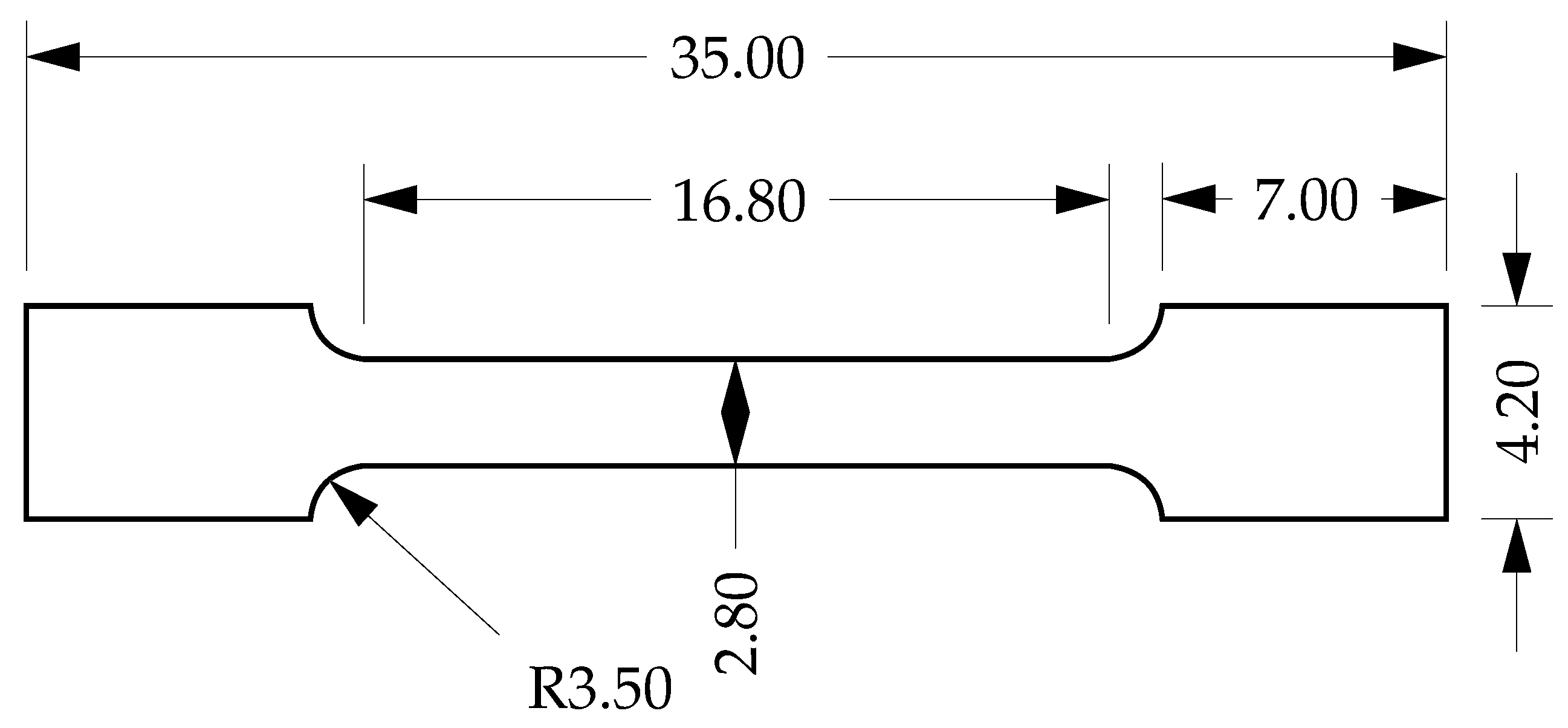
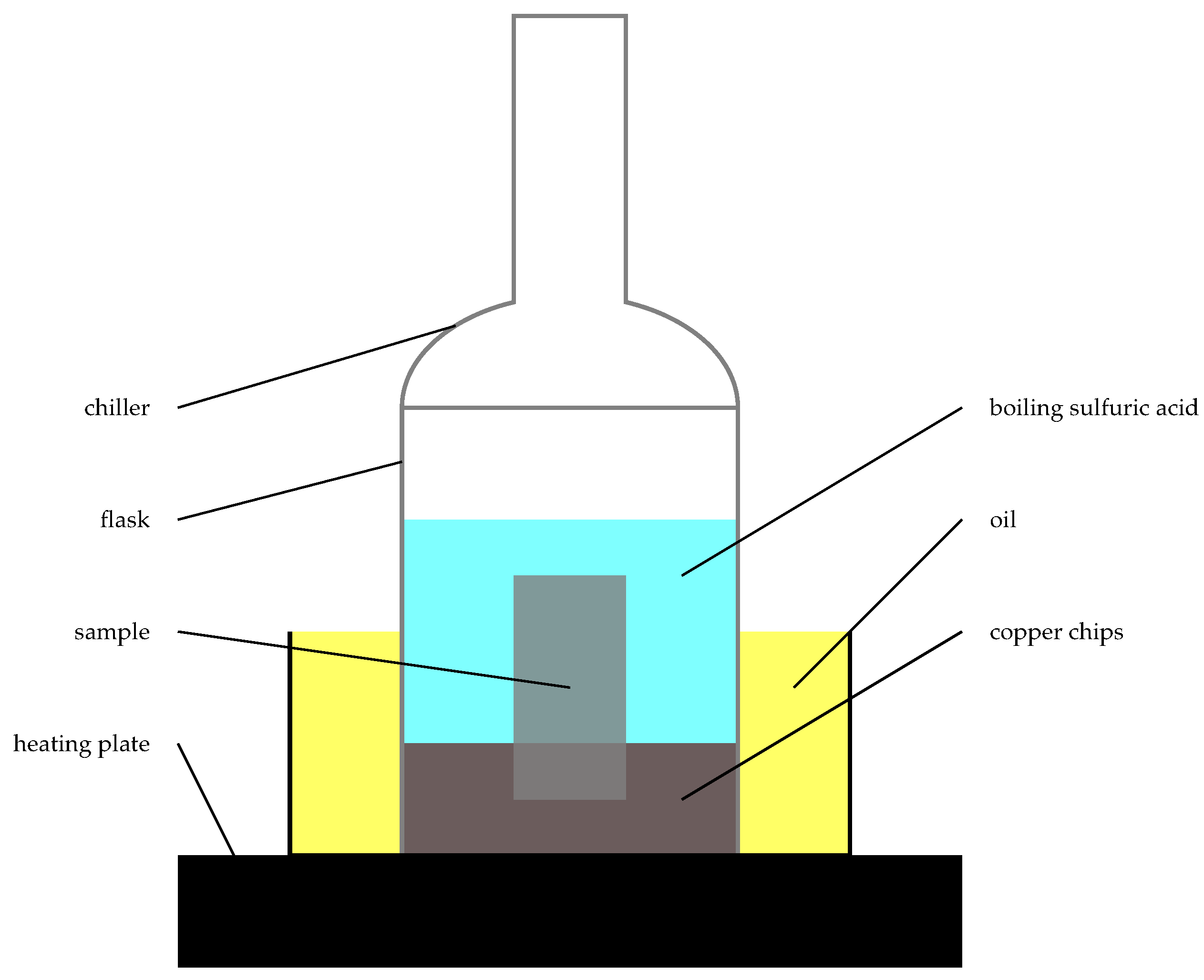
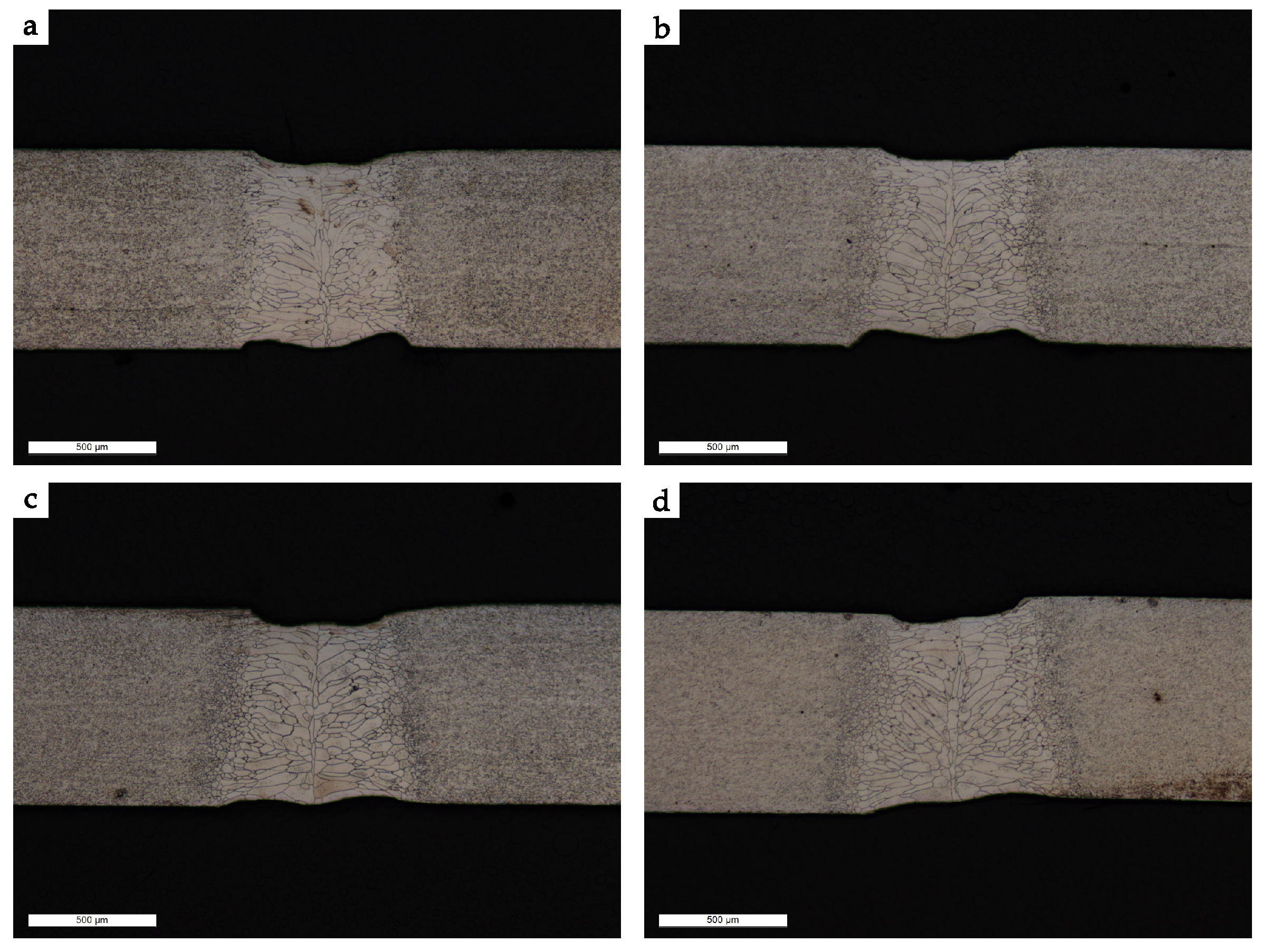


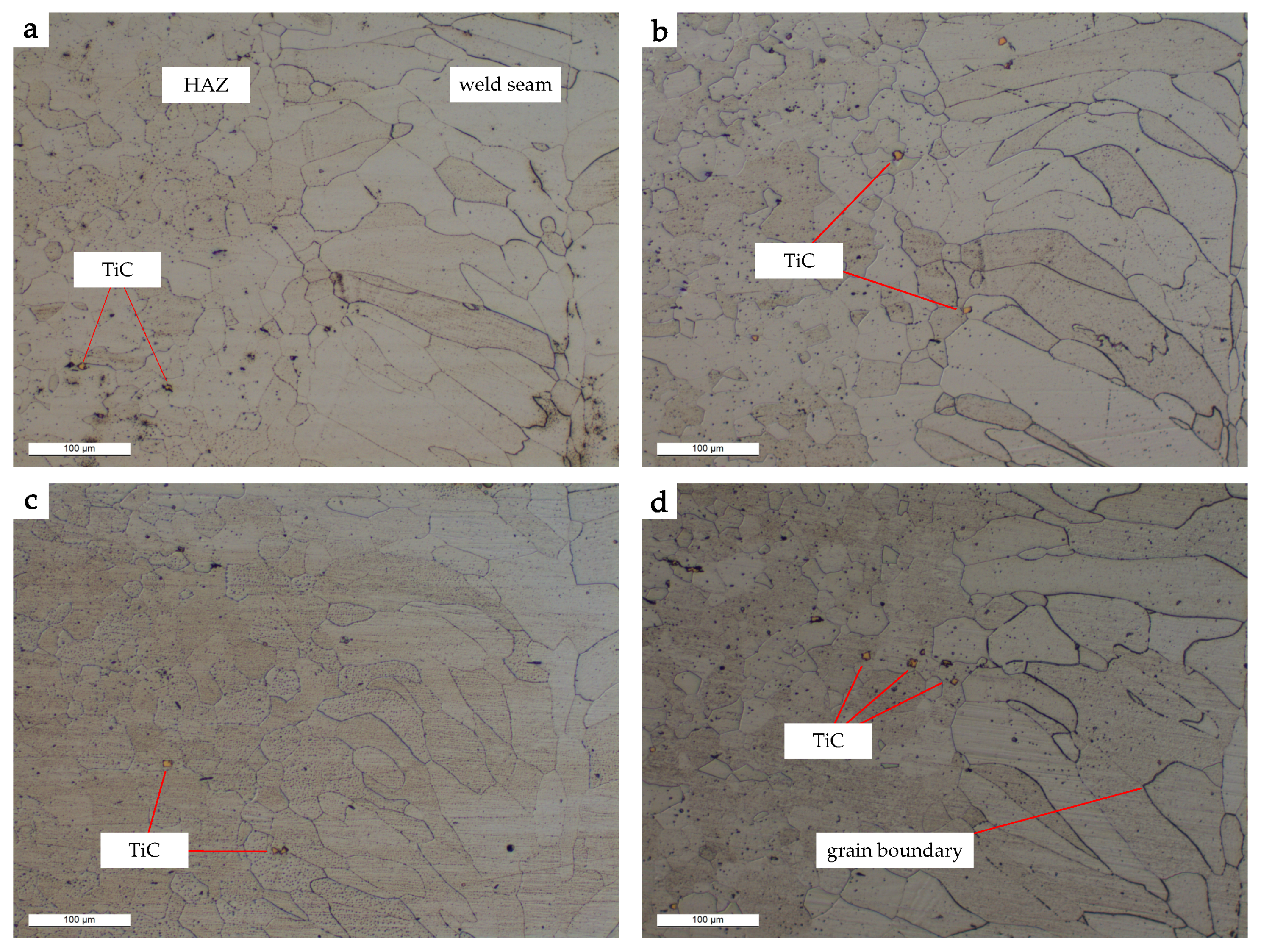


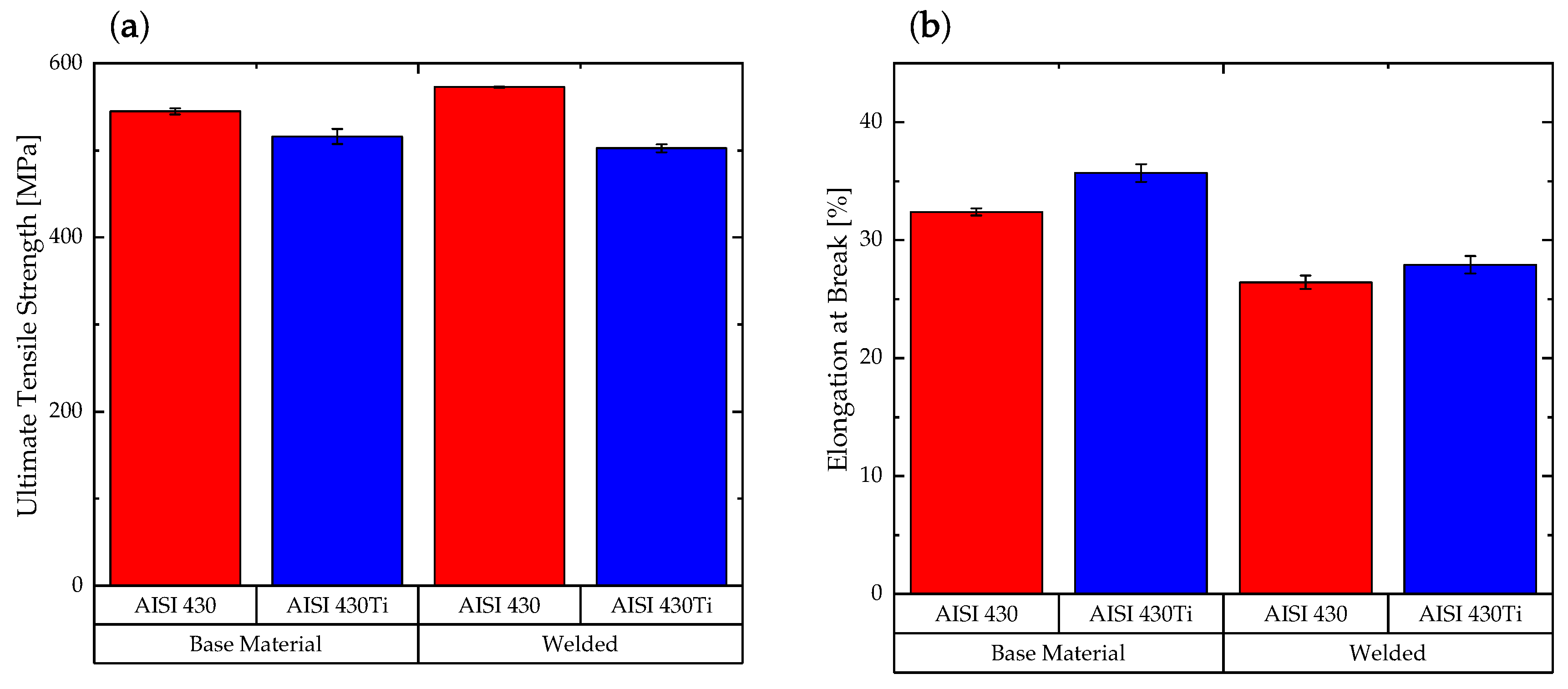

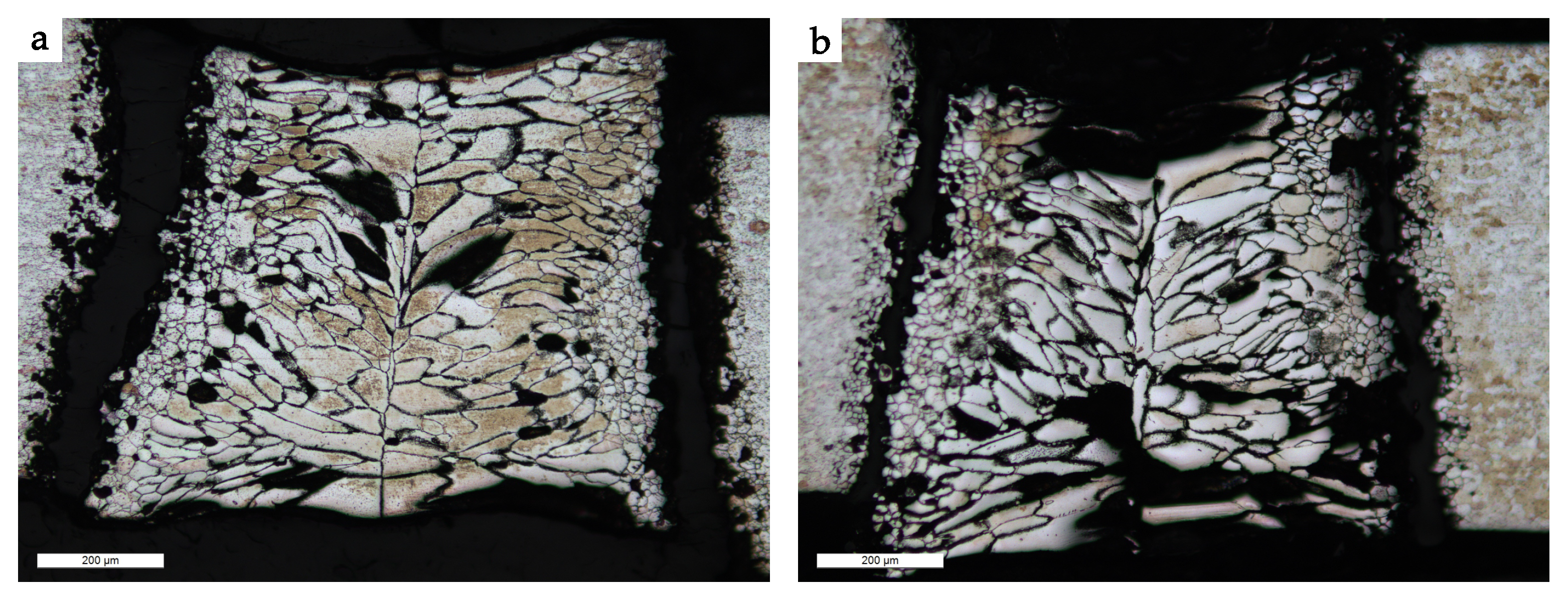

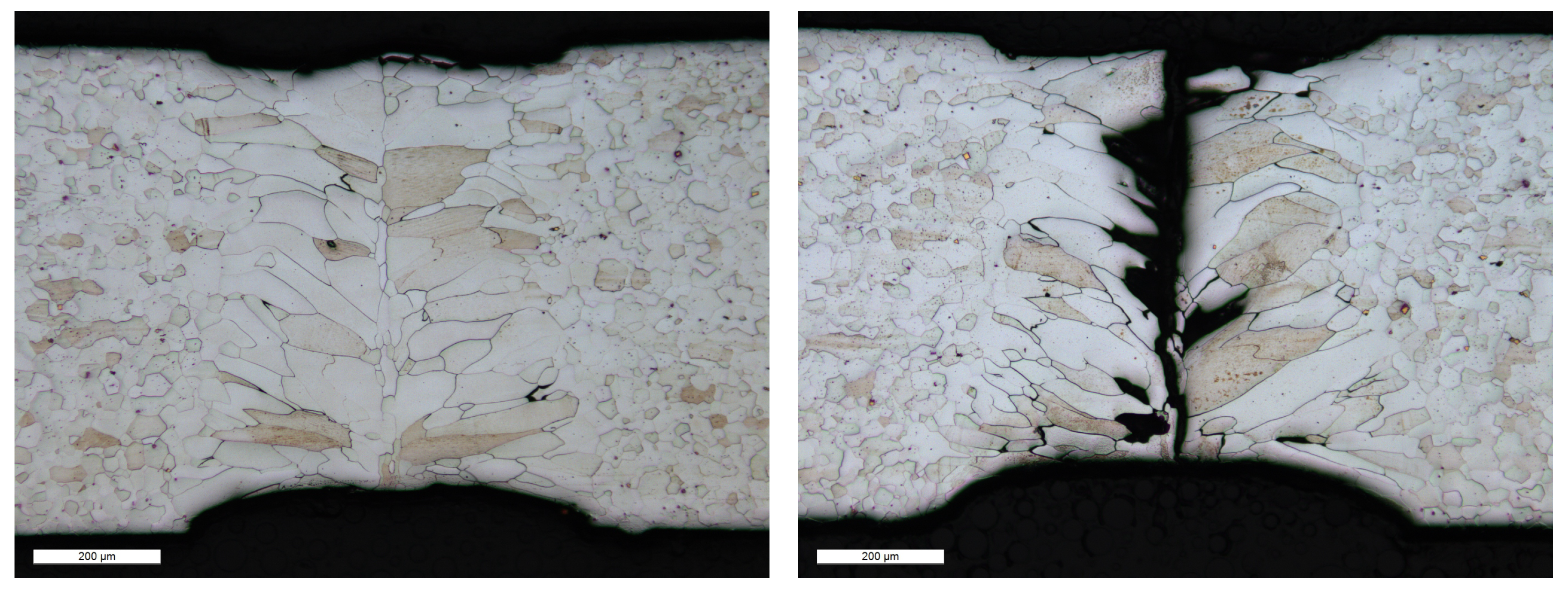

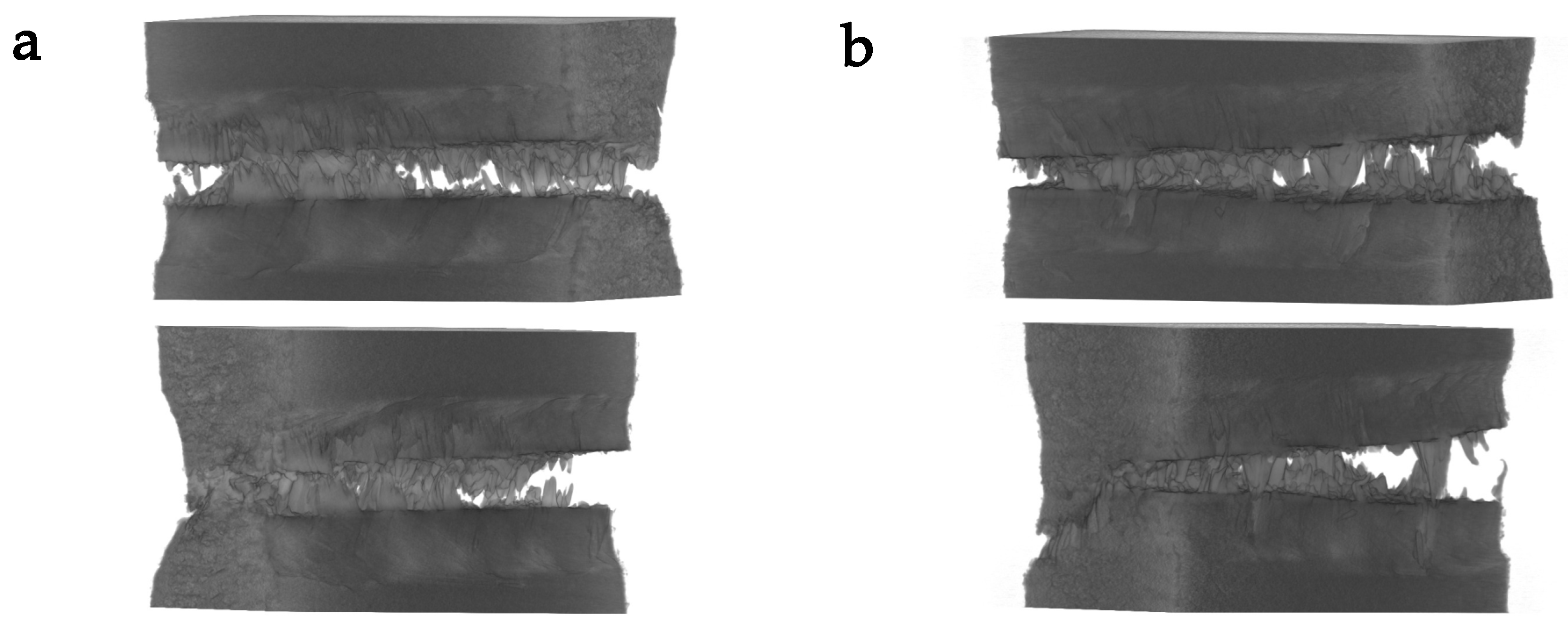
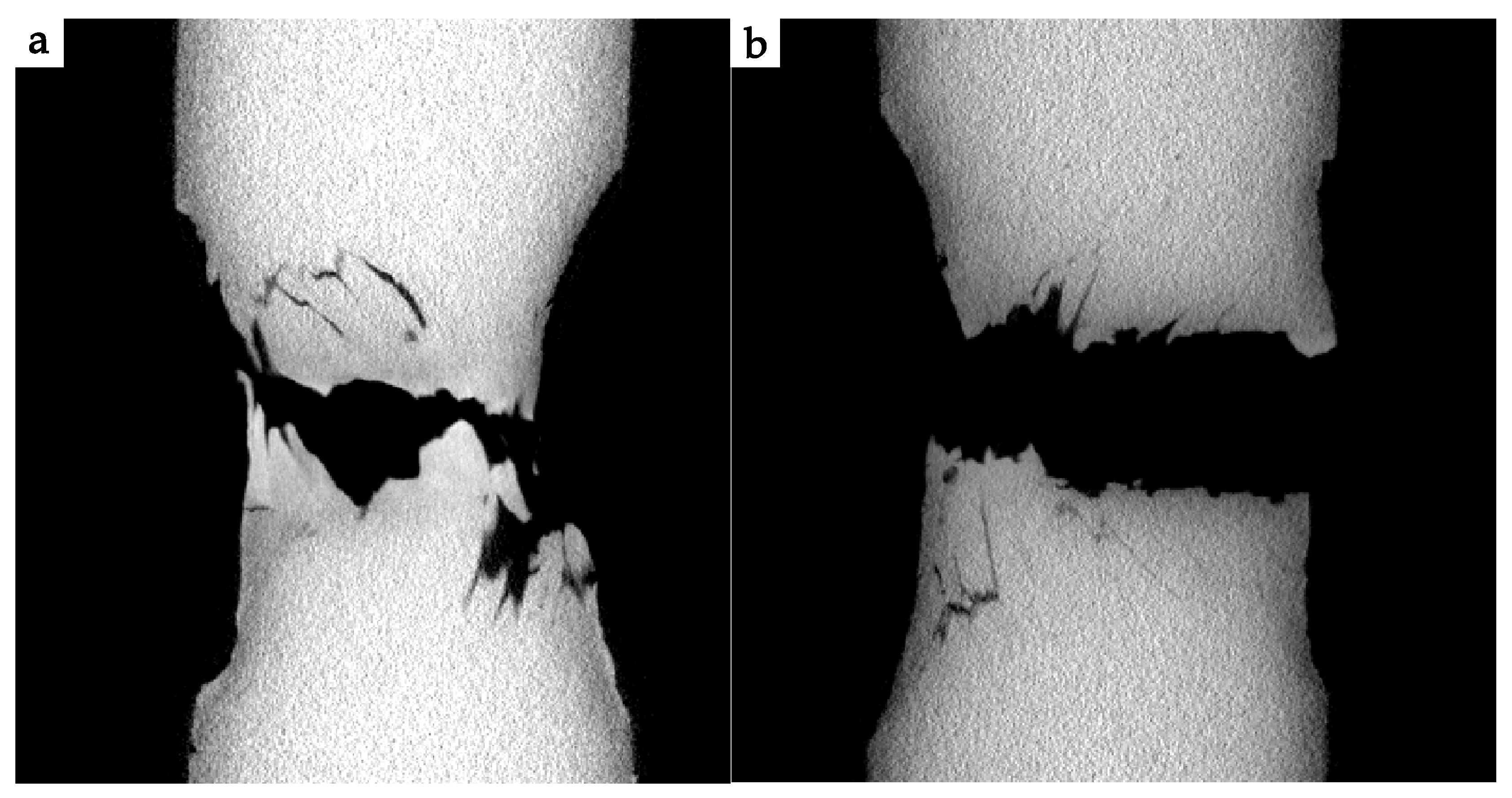
| (a) | Chemical Composition [wt.%] | ||||||
| Fe | C | N | Cr | Ti | Ni | Mo | |
| nominal | bal. | 0.08 | 0.04 | 16.00 | 0.00 | 0.00 | 0.00 |
| actual | bal. | 0.041 | 0.142 | 16.18 | 0.001 | 0.156 | 0.046 |
| (b) | Chemical Composition [wt.%] | ||||||
| Fe | C | N | Cr | Ti | Ni | Mo | |
| nominal | bal. | 0.05 | 0.04 | 16.00 | 0.80 | 0.00 | 0.00 |
| actual | bal. | 0.018 | 0.079 | 16.18 | 0.326 | 0.260 | 0.046 |
| Sample | Traverse Speed | Laser Power | Welding Energy Input |
|---|---|---|---|
| [mm·s] | [W] | [J·mm] | |
| 1 | 40 | 720 | 18 |
| 2 | 40 | 800 | 20 |
| 3 | 40 | 880 | 22 |
| 4 | 40 | 960 | 24 |
© 2020 by the authors. Licensee MDPI, Basel, Switzerland. This article is an open access article distributed under the terms and conditions of the Creative Commons Attribution (CC BY) license (http://creativecommons.org/licenses/by/4.0/).
Share and Cite
Sommer, N.; Kryukov, I.; Wolf, C.; Wiegand, M.; Kahlmeyer, M.; Böhm, S. On the Intergranular Corrosion Properties of Thin Ferritic Stainless Steel Sheets Welded by Fiber-Laser. Metals 2020, 10, 1088. https://doi.org/10.3390/met10081088
Sommer N, Kryukov I, Wolf C, Wiegand M, Kahlmeyer M, Böhm S. On the Intergranular Corrosion Properties of Thin Ferritic Stainless Steel Sheets Welded by Fiber-Laser. Metals. 2020; 10(8):1088. https://doi.org/10.3390/met10081088
Chicago/Turabian StyleSommer, Niklas, Igor Kryukov, Christian Wolf, Michael Wiegand, Martin Kahlmeyer, and Stefan Böhm. 2020. "On the Intergranular Corrosion Properties of Thin Ferritic Stainless Steel Sheets Welded by Fiber-Laser" Metals 10, no. 8: 1088. https://doi.org/10.3390/met10081088
APA StyleSommer, N., Kryukov, I., Wolf, C., Wiegand, M., Kahlmeyer, M., & Böhm, S. (2020). On the Intergranular Corrosion Properties of Thin Ferritic Stainless Steel Sheets Welded by Fiber-Laser. Metals, 10(8), 1088. https://doi.org/10.3390/met10081088





